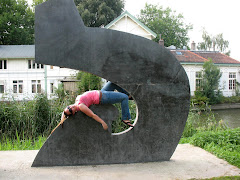*With apologies to Dumas and all the Google users who have found this page by searching for the Musketeers' battle cry. Salut, by the way.
Tuesday, 12 August 2008.
Tuesday, 12 August 2008.
Welcome to Paris. Quoi de neuf?
L and I made a leisurely start to the morning...there must have been coffee...before taking the Métro to a station under Montmartre, the highest hill in central Paris. We climbed a lot of stairs up to Sacré Cœur. It was almost unbearably hot that morning and I was wearing shorts, so I was unable to get more than a few steps inside the basilica because there was a service going on. I would have worn pants had I known we were going straight to church. Ladies, take note, don't wear shorts in Europe. It was actually quite funny: we joined the crowd pushing to enter the church, and there was a funny little man standing off to one side of the entrance. He wouldn't look straight at anyone, but when I came near, he started growling "Nooooooooo shorrrrrrrrrtz."
We walked across to look out over Paris. We could see all the landmarks: the Eiffel Tower, the Arc de Triomphe, the Louvre. L says the view from Montmartre is better than from the Eiffel Tower. We went into the Espace Dalí, a little Salvadore Dalí museum. I didn't have much appreciation for Dalí (or any surrealism) previously, but now I understand. My favorite was the 12 Tribes of Israel, thirteen etchings he did for the 25th anniversary of the State of Israel in 1972.
We walked across to look out over Paris. We could see all the landmarks: the Eiffel Tower, the Arc de Triomphe, the Louvre. L says the view from Montmartre is better than from the Eiffel Tower. We went into the Espace Dalí, a little Salvadore Dalí museum. I didn't have much appreciation for Dalí (or any surrealism) previously, but now I understand. My favorite was the 12 Tribes of Israel, thirteen etchings he did for the 25th anniversary of the State of Israel in 1972.
After we left the museum, L pointed out the neighborhood from the film Amélie, including the little market she visits. It was chock-full of Amélie postcards.
 Au Marche de la Butte - the market from the film Amélie
Au Marche de la Butte - the market from the film AmélieWe headed down from the hill to continue our walking tour of Paris. That is to say, we went down to old Moulin Rouge and strutted our stuff on the street.
Just kidding. We only walked past and took pictures of the revue that gave us the only French phrase known to most of my generation (and if you don't know what I'm talking about, you clearly haven't seen the film), mocking all the high school students that were so intrigued by it and the sex shops in the vicinity.
Just kidding. We only walked past and took pictures of the revue that gave us the only French phrase known to most of my generation (and if you don't know what I'm talking about, you clearly haven't seen the film), mocking all the high school students that were so intrigued by it and the sex shops in the vicinity.
From there we went to the Jardin du Luxembourg. It's like most of the gardens I saw in France and Belgium: trees grow in straight lines in bare, sandy soil, statues poke out from the trees like Robin Hood's band of merry men, and there are always lots of sunbathers draped around the fountains. Sometimes there's even grass in the parks.
 La Statue
La Statue Piscine reverse peristalsis in Jardin du Luxembourg
Piscine reverse peristalsis in Jardin du LuxembourgNot far from the Jardin du Luxembourg is the Panthéon, the resting place of grands hommes Voltaire, Rousseau, Hugo, Dumas, Braille; and grand femme Marie Curie. C'est magnifique.
 The Panthéon
The PanthéonOur next stop was L's Roman ampitheatre, the Arènes de Lutèce in the Latin Quarter. It's a 15,000 seat arena was built in the first century, destroyed in the third, and filled in during the thirteenth. It was rediscovered in the 1860s and Victor Hugo campaigned to preserve it. It was fully excavated at the end of the first World War, and now it's a public park and garden. You can walk around it and check out the stage, the niches, and the barred animal cages. Naturally, kids love to play in the arena, and L brought a friend once who sat in the stands and shouted commentary: "Boo! Send out the lions!" and "12 denarii on the dwarf!"
 In the Arènes de Lutèce
In the Arènes de LutèceWe took our books and laid out on the grass in the arena for an hour or two. There were two guys near us who apparently created a public disturbance, because they were approached and patted down by five policemen for about 15 minutes. We couldn't imagine how a good time and a bottle of booze could warrant that, but the policemen left them alone after a bit and they carried on as though nothing had happened.
One thing I love about Paris: it's divided into twenty neighborhoods, or arrondissements. L lives in the fifth arrondissement. The arrondissement is usually noted on the side of the buildings, so you know where you are, however, it is abbreviated. Thus, L lives in the Fifth Arr. of Paris. How very piratey.
And it's ok if I'm the only person who laughs about that.
One thing I love about Paris: it's divided into twenty neighborhoods, or arrondissements. L lives in the fifth arrondissement. The arrondissement is usually noted on the side of the buildings, so you know where you are, however, it is abbreviated. Thus, L lives in the Fifth Arr. of Paris. How very piratey.
And it's ok if I'm the only person who laughs about that.

















